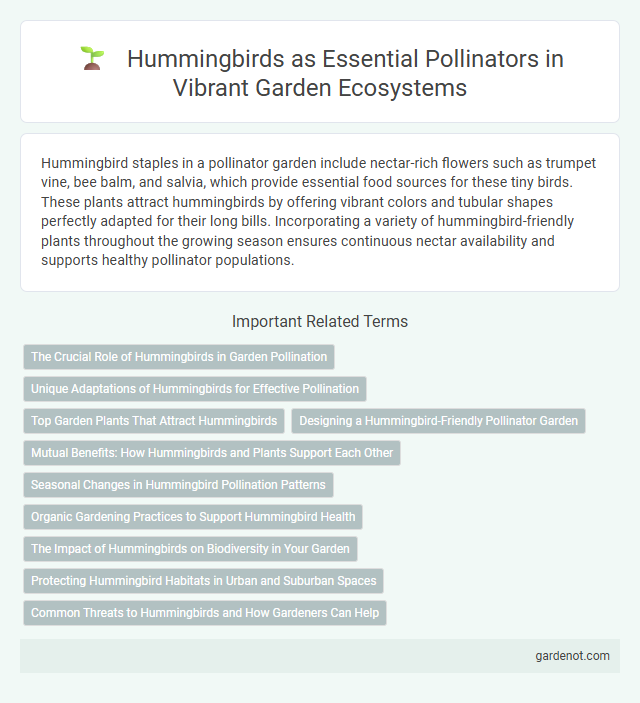Hummingbird staples in a pollinator garden include nectar-rich flowers such as trumpet vine, bee balm, and salvia, which provide essential food sources for these tiny birds. These plants attract hummingbirds by offering vibrant colors and tubular shapes perfectly adapted for their long bills. Incorporating a variety of hummingbird-friendly plants throughout the growing season ensures continuous nectar availability and supports healthy pollinator populations.
The Crucial Role of Hummingbirds in Garden Pollination
Hummingbirds play a vital role in garden pollination by efficiently transferring pollen while feeding on nectar from tubular flowers. Their rapid wing movement and ability to hover enable them to access deep blooms that many insects cannot reach, making them indispensable pollinators for plants like trumpet vine, bee balm, and salvia. Supporting hummingbird populations through cultivating nectar-rich flowers enhances biodiversity and improves the health and productivity of pollinator gardens.
Unique Adaptations of Hummingbirds for Effective Pollination
Hummingbirds possess specialized wing structures that enable rapid, precise hovering, allowing them to access nectar deep within flowers. Their long, slender bills and extendable tongues are uniquely adapted to extract nectar from tubular blossoms, ensuring pollen transfer during feeding. High metabolism drives frequent visits to diverse flowers, making hummingbirds vital agents in the pollination of many native plant species.
Top Garden Plants That Attract Hummingbirds
Top garden plants that attract hummingbirds include tubular flowers such as bee balm, salvia, and trumpet vine, which provide abundant nectar. Red, orange, and pink blossoms are especially attractive due to hummingbirds' color vision preferences. Incorporating native species like columbine and coral honeysuckle enhances habitat compatibility and supports local pollinator populations.
Designing a Hummingbird-Friendly Pollinator Garden
Designing a hummingbird-friendly pollinator garden involves selecting nectar-rich flowers such as trumpet vine, bee balm, and salvia that provide vibrant, tubular blooms attracting hummingbirds. Incorporating a variety of native flowering plants ensures continuous nectar availability throughout the growing season, supporting hummingbird energy needs. Providing perches, fresh water sources like shallow fountains, and avoiding pesticides creates a safe environment promoting hummingbird activity and garden biodiversity.
Mutual Benefits: How Hummingbirds and Plants Support Each Other
Hummingbirds play a crucial role in pollinator gardens by transferring pollen while feeding on nectar, which supports plant reproduction and biodiversity. The deep, tubular flowers of many garden plants have evolved to accommodate hummingbirds' long beaks, ensuring efficient nectar access and effective pollination. This mutualistic relationship enhances seed production for plants and provides essential energy sources for hummingbirds, sustaining both populations.
Seasonal Changes in Hummingbird Pollination Patterns
Hummingbird pollination patterns shift noticeably with seasonal changes, as these birds migrate and adapt their feeding habits to blooming cycles. Plants like trumpet vine and bee balm provide essential nectar sources during spring and summer, supporting hummingbird energy needs. Understanding these seasonal dynamics helps optimize pollinator garden planting schedules to enhance hummingbird attraction and pollination success.
Organic Gardening Practices to Support Hummingbird Health
Organic gardening practices such as planting native nectar-rich flowers and avoiding synthetic pesticides create a safe habitat that supports hummingbird health and attracts these vital pollinators. Incorporating plants like bee balm, trumpet vine, and salvia increases natural food sources while promoting biodiversity in the pollinator garden. Maintaining pesticide-free, organically enriched soil ensures hummingbirds receive uncontaminated nectar essential for their energy and survival.
The Impact of Hummingbirds on Biodiversity in Your Garden
Hummingbirds play a crucial role in enhancing garden biodiversity by pollinating a wide variety of native plants that other pollinators often overlook. Their ability to transfer pollen while feeding on nectar from tubular flowers supports the reproductive success of many flowering species, leading to increased plant diversity. By attracting hummingbirds, gardeners can foster a balanced ecosystem that benefits insects, birds, and other wildlife, promoting a thriving pollinator garden environment.
Protecting Hummingbird Habitats in Urban and Suburban Spaces
Hummingbird staple plants such as bee balm, salvia, and trumpet vine provide essential nectar sources that support hummingbird populations in urban and suburban gardens. Protecting hummingbird habitats involves cultivating native flowering plants, minimizing pesticide use, and preserving natural green spaces to ensure healthy food supplies and safe nesting areas. Creating pollinator-friendly environments enhances biodiversity and supports hummingbird migration and survival amidst expanding urban development.
Common Threats to Hummingbirds and How Gardeners Can Help
Common threats to hummingbirds include habitat loss, pesticide exposure, and climate change, which reduce food sources and nesting sites. Gardeners can support hummingbirds by planting native nectar-rich flowers, avoiding chemical pesticides, and providing fresh water sources. Creating a diverse, pesticide-free pollinator garden enhances habitat connectivity and promotes hummingbird survival.
Hummingbird staple Infographic

 gardenot.com
gardenot.com